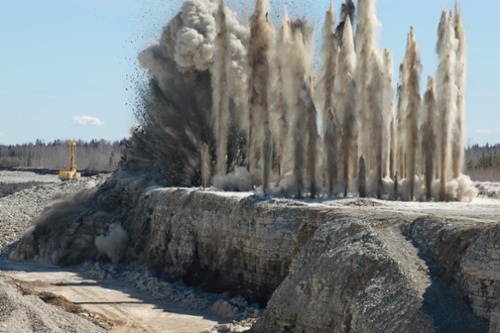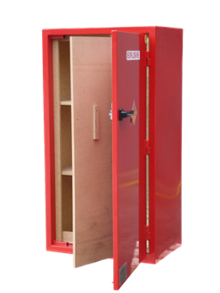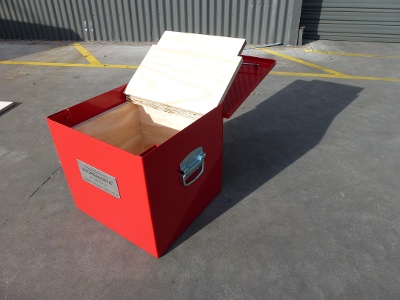While all classes of dangerous goods must be handled and stored safely, it’s fair to say that explosive substances require special consideration. Recognised as Class 1 substances, explosives are necessary for a range of industries including mining, construction, oil and gas, and pyrotechnics. But what are the explosive storage cabinet requirements within Australia? This post details the necessary features of a portable explosive magazine, such as an explosive storage cabinet or day box. We’ll go through each of the requirements as per the Australian Standards and detail how this reduces the risks associated with Class 1 substances.
What Australian Standard Relates To Explosives?
When we look at the best practice for dangerous goods storage, the Australian Standards are always the most comprehensive guide. In line with the general requirements outlined in the WHS Regulations, the Standards offer detailed requirements that specifically relate to the handling and storage of dangerous goods, such as explosives.
The Standard that relates to the storage of Class 1 Explosive Substances is AS 2187 - Explosives - Storage, transport and use.
While there are a multitude of storage options for explosives (bulk storage, above-ground, underground etc), we will be focusing on explosives storage cabinets, which are defined as ‘portable magazines’ in the Standard.

Class 1 substances are necessary for a range of applications from mining, oil and gas to the pyrotechnics industry.
General Requirements For Portable Magazines
To minimise risk to people, property and the environment, there are a range of construction requirements that relate to relocatable steel magazines.
Portable magazines are regarded as Class 1 storage that is kept inside, within a building.
When considering the general requirements that pertain to your storage cabinet you must remember to allow for the following:
- LOCATION – portable magazines must be stored on the ground floor of your building. They must be placed close to an exterior door to assist with emergency service access and evacuations
- SEGREGATION – when considering placement of your cabinet, ensure that it is located no less than 5 metres from goods of a corrosive, combustible or flammable nature
- SIGNAGE – to assist with hazard identification, the location must be fitted with signage (at a fixed height visible from exterior door) stating:
EXPLOSIVES; or
DETONATORS - SEPARATE STORAGE – there must be separate storage for the following:
All explosives, detonating cord, boosters and primers which are not or do not contain detonators
Detonators, detonating relays and capped fuses; and
Safety fuses, fuse igniters, multiple fuse igniters, igniter cords, igniter cord connectors and electric ignitors
IMPORTANT: Any portable magazines that contain detonators must be separated from portable magazines that contain other blasting explosives, with distances of no less than 3 metres as stated in Table 3.2.3.1 of the Australian Standard AS 2187.
Construction Requirements
Whether you’re installing an explosive cabinet, or you’re transporting explosives in a day box, there are specific construction requirements that relate to these types of explosive magazines.
REMEMBER: Always ensure that there is security for your explosives store. Class 1 substances must be located in secured premises and protected from the elements.
Construction requirements for explosive cabinets include:
CONSTRUCTION MATERIALS – your explosives storage cabinet should be constructed of steel (no less than 0.8mm thick) or aluminium (no less than 1.1 mm thick) sheeting
Manufacturing a cabinet from thick sheet steel or aluminium provides protection against impact damage, segregation for incompatible substances and protection against extreme temperatures.
CABINET LINING – cabinets or boxes should be internally lined with wood (or water-resistant plywood no less than 19mm thick – as per AS 2270), securely fastened to the construction materials
Lining a relocatable steel magazine with wood or water-resistant plywood ensures that any potential explosion will be suppressed. This type of material must be non-combustible and provide insulation for the stored goods. The timber or plywood should be coated to reduce light absorption and maximise light reflection, thereby reducing the temperature within the cabinet.
LID – the explosives cabinet or box must be fitted with a close-fitting lid.
As with most types of dangerous goods cabinets, ensuring that the cabinet or day box is constructed with a close-fitting lid enables the goods within the storage equipment to be contained in the event of an explosion incident.
LID FASTENINGS – lids must be secured by a hasp, staple and hinges all made from steel
IMPORTANT: If you are storing gunpowder in your explosive cabinet, the requirement for lid fastenings is different. The Standard explains that the hasp, staple and hinges should be copper or copper alloy.
LOCK – the cabinet must be fitted with a lock that complies with Clause 2.1.10 of the Standard
Due to the serious risks that Class 1 substances pose, ensuring security for your store is a top priority. It is a requirement of the Australian Standards that all portable explosives storage be fitted with a specific lock to deter unathorised entry and theft.
HANDLES – portable explosives storage needs to be fitted with handles
As explosives storage cabinets are regarded as portable magazines, they must be constructed to be easily relocated. Cabinets and boxes should be manufactured with sturdy handles so that the storage equipment can be lifted and relocated when required.
PAINT COATING – explosives storage should be painted internally and externally
It’s a requirement of the Standard that the external construction materials of the store are protected against corrosion. However, painting the explosives storage cabinet internally assists with the prevention of light absorption and heat within the storage equipment.
Complexity Of Construction
When considering the construction features of an explosive cabinet, it’s important to understand the complexity of the construction due to the internal plywood lining.
When comparing this type of cabinet to a standard flammable cabinet, you can see that the wooden inserts are highly technical in their construction.
STOREMASTA manufactures high quality Australian-made cabinets that meet these complex safety specifications. We take the time to construct each explosive cabinet individually, to ensure that the internal plywood lining is providing customers with the highest standard of protection against explosion.
Key Safety Features Of Compliant Class 1 Storage
As we’ve detailed in the previous section, there are many requirements that are necessary for an explosive storage cabinet to be deemed compliant. When seeking storage for your Class 1 substances, you should be mindful of the following safety features:
- Sheet steel construction
- Fully welded seams
- Lined internally with plywood or wood
- Close-fitting doors or lid
- Heavy duty hinges
- Secure locking system
- Equipped with dangerous goods and hazard signage
IMPORTANT: To be deemed compliant, storage equipment must be designed and manufactured to meet all the requirements of AS 2187-1998. Check with your supplier or chemical storage manufacturer to see if the equipment you’re considering is made in full conformance with Australian Standards.
Other Considerations
When you’re working with explosive materials at your jobsite, there are other factors that you should also consider when determining your Class 1 storage needs.
These include:
- Staff training – dangerous goods training is essential for any staff members who are working in any explosive handling or storage areas. Training should not only include hazard awareness and safe work practices, but it should also detail the features of your storage equipment and how the cabinet or box should be used.
- Ventilation – if vapours build-up in explosives cabinets, there is an increased risk to your staff and the surrounding community. Some cabinets may require the installation of mechanical ventilation to assist with the safe dispersion of vapours.
- Ignition sources – under no circumstance should any type of ignition source be kept near or in the explosive storage equipment. This may include power points, electric lights, naked flames, heat sources or electrical equipment.
- Compatibility – there are strict compatibility requirements that relate specifically to Class 1 explosives. Refer to the classification code within the Australian Standard to determine the compatibility group of your explosive substances.
- Separation distances – Class 1 explosives are subject to stringent requirements relating to the separation of explosives storage from a range of goods and places including detonators, associated works, protected works, and Division 1.4 explosives. As this is a complex issue, please speak with a Dangerous Goods Consultant or have your staff refer to the relevant section of AS 2187-1998 for full details on the required separation distances.
REMEMBER: We strongly recommend that any business handling explosive substances undertake a thorough risk assessment before purchasing any type of storage of handling equipment. If you require assistance conducting a risk assessment on your explosives and dangerous goods handling and storage areas, you can contact a Dangerous Goods Consultant or DG Specialist to help you determine the risks present in your workplace.
Reducing Explosion Risk With Compliant Storage
To reduce the risk of explosion on your jobsite, it's essential that you take the time to ensure that your handling and storage practices for Class 1 substances are 100% compliant. The simplest way to create a safer storage situation for your explosives, dynamite and detonators is to install a cabinet that's been manufactured to meet the requirements of the Australian Standard AS 2187-1998.
One of the key safety considerations your organisation must also make (preferably during your risk assessment) is how to store explosive substances safely and without sparking a dangerous chemical reaction with your other onsite chemicals. If your organisation is one of the many that relies on explosives substances, we have an eBook that can assist with the dangerous goods segregation process. To learn more about separating incompatible classes of dangerous goods, simply click on the below image to access our free guide today.
Joining the team as a Dangerous Goods Storage Consultant, Melissa Hampton became Storemasta's Marketing Manager in late 2021. With extensive knowledge and experience in chemical compliance, Melissa is responsible for leading the Marketing team and helping shape their marketing strategy. In her spare time, you can find Melissa hiking, swimming and enjoying the great outdoors in beautiful north-west Tasmania.


